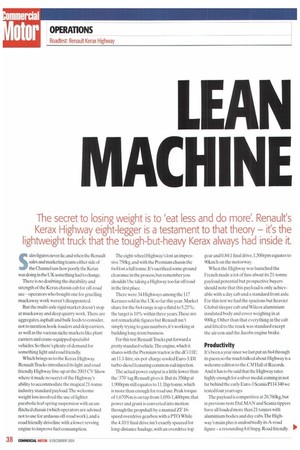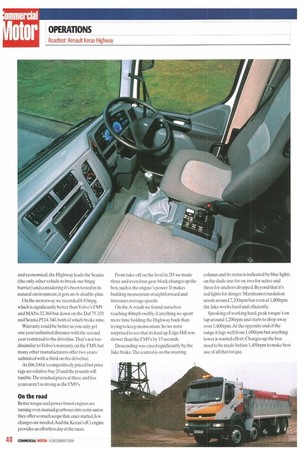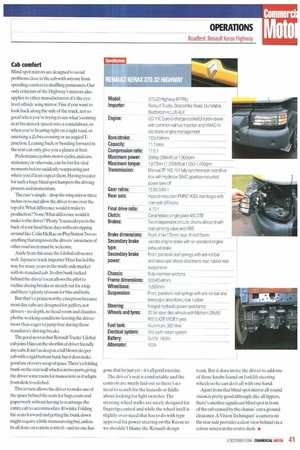LE AN MAC HI N E
Page 40

Page 42

Page 43

If you've noticed an error in this article please click here to report it so we can fix it.
The secret to losing weight is to 'eat less and do more'. Renault's Kerax Highway eight-legger is a testament to that theory — it's the lightweight truck that the tough-but-heavy Kerax always had inside it.
Sales figures never lie,and when the Renault sales and marketing teams either side of the Channel saw how poorly the Kerax was doing in the UK something had to change.
There is no doubting the durability and strength of the Kerax chassis cab for off-road use— operators who bought one for gruelling muckaway work weren't disappointed.
But the multi-axle rigid market doesn't stop at muckaway and deep quarry work. There are aggregates, asphalt and bulk feeds to consider, not to mention hook-loaders and skip carriers, as well as the various niche markets like plant carriers and crane-equipped specialist vehicles. So there's plenty of demand for something light and road friendly.
Which brings us to the Kerax Highway. Renault Trucks introduced its light and road friendly Highway line-up at the 2003 CV Show where it made no secret of the Highway's ability to accommodate the magical 21-tonne industry standard payload.The welcome weight loss involved the use of lighter parabolic leaf-spring suspension with an unI:filched chassis (which operators are advised not to use for arduous off-road work), and a road friendly driveline with a lower revving engine to improve fuel consumption. The eight-wheel Highway's lost an impressive 750kg,and with the Premium chassis the 6x4 lost a full tonne. It's sacrificed some ground clearance in the process,but remember you shouldn't be taking a Highway too far off road in the first place.
There were 34 Highways among the 117 Keraxes sold in the UK so far this year. Market share for the 8x4 range is up a third to 5.25%; the target is 10% within three years.These are not remarkable figures but Renault isn't simply trying to gain numbers, it's working at building long-term business.
For this test Renault Trucks put forward a pretty standard vehicle.The engine, which it shares with the Premium tractor, is the dCi 11E: an 11.1-litre, six-pot charge-cooled Euro-3,D1 turbo-diesel featuring common-rail injection.
The actual power output is a little lower than the '370' tag Renault gives it. But its 356hp at 1.900rpm still equates to 11.1hp/tonne. which is more than enough for road use. Peak torque of 1,670Nm is on tap from 1,050-1,400rpm; that power and grunt is converted into motion through the propshaft by a manual ZF 16speed overdrive gearbox with a PTO. While the 4.10:1 final drive isn't exactly specced for long-distance haulage, with an overdrive top gear and 0.84:1 final drive, 1,500rpm equates to 90Ian/h on the motorway.
When the Highway was launched the French made a lot of fuss about its 21-tonne payload potential but prospective buyers should note that this payload is only achievable with a day cab and a standard front axle. For this test we had the spacious but heavier Global sleeper cab and Wilcox aluminium insulated body and cover weighing in at 900kg. Other than that everything in the cab and fitted to the truck was standard except the air-con and the Jacobs engine brake.
Productivity
ifs been a year since we last put an 8x4 through its paces, so the much talked about Highway is a welcome edition to the CM Hall of Records.
And it has to be said that the Highway rates highly enough for a silver medal coming in not far behind the early Euro-3 Scania P114 340 we tested four years ago.
The payload is competitive at 20,760kg, but in previous tests Daf. MAN and Scania tippers have all loaded more than 21 tonnes with aluminium bodies and day cabs.The High way's main plus is undoubtedly its A-road figure — a resounding 8.63mpg. Road friendly 11110 and economical, the Highway leads the Scania (the only other vehicle to break our 8mpg barrier) and considering it's been tested in its natural environment, it gets an A-double-plus.
On the motorway we recorded 8.83mpg, which is significantly better than Volvo's FM9 and MANs 32.364 but down on the Daf 75.320 and Scania P114.340, both of which broke nine.
Warranty could be better as you only get one year/unlimited distance with the second year restricted to the driveline.That's not too dissimilar to Volvo's warranty on the FM9.but many other manufacturers offer two years/ unlimited with a third on the driveline.
At £66,100 it's competitively priced but price tags are relative buy 20 and the pounds will tumble.The residual prices at three and five years aren't as strong as the FM9's.
On the road
Better torque and power-based engines are turning even manual gearboxes into semi-autos: they offer so much scope thatonce started, few changes are needed.And the Kerax's dCi engine provides an effortless day at the races. From take-off on the level in 21-1 we made three and even four-gear block changes up the box,such is the engine's power. It makes building momentum straightforward and increases average speeds.
On the A-roads we found ourselves reaching 40mph swiftly; if anything we spent more time holding the Highway back than trying to keep momentum. So we were surprised to see that its haul up Edge Hill was slower than the FM9's by 15 seconds.
Descending was eased significantly by the Jake brake.The control is on the steering column and its status is indicated by blue lights on the dash: one for on, two for active and three for anchors dropped. Beyond that it's red lights for danger. Maximum retardation needs around 2,200rpm but even at 1,800rpm the Jake works hard and efficiently.
Speaking of working hard, peak torque's on tap around 1,200rpm and starts to drop away over 1,400rpm. At the opposite end of the range it lugs well from1.000rpm but anything lower is wasted effort. Changes up the box need to be made before 1,450rpm to make best use of all that torque. Cab comfort Blind-spot mirrors are designed to avoid problems close to the cab with anyone from speeding couriers to shuffling pensioners. Our only criticism of the Highway's mirrors also applies to other manufacturers: it's the eyelevel offside wing mirror. Fine if you want to look back along the side of the truck, not so good when you're trying to see what's coming in at breakneck speed onto a roundabout, or when you're bearing right on a tight road, or assessing a Zebra crossing or an angled Tjunction. Leaning back or bending forward in the seat can only give you a glance at best.
Pedestrians, cyclists, motor cycles, and cars. stationary or otherwise,can be lost for vital moments before suddenly reappearing just where you'd least expect them. Having to cater for such a huge blind spot hampers the driving process and momentum.
The cure's simple — drop the wing mirror three inches or so and allow the driver to see over the top of it.I.Vhat difference would it make to production? None, What difference would it make to the driver? Plenty. You need eyes in the back of your head these days with cars zipping around like Colin McRae on PlayStationTwo so anything that improves the drivers' awareness of other road users must be welcome.
Aside from this issue the Global cab scores well. Japanese truck importer Hino has led the way for many years in the multi-axle market with its standard cab. Its slim bunk tucked behind the driver's seat allows the pilot to recline during breaks or stretch out for a kip. and there's plenty of room for bits and bobs.
But that's a praiseworthy exception because most day cabs are designed for gaffers, not drivers — no depth. no head room and claustrophobic working conditions leaving the driver more than eager to j ump free during those mandatory driving breaks.
The good news is that RenaultTrucks' Global cab joins Hino on the shortlist of driver friendly day cabs. It isn't as deep as a full blown sleeper cab with a rigid bottom bunk but it does make good use of every scrap of space.There's a folding bunk on the rear wall which is in two parts, giving the driver some room for manoeuvre as it adapts from desk to sofa bed.
This in turn allows the driver to make use of the space behind the seats for bags, coats and paperwork without having to rearrange the entire cab to accommodate 40 winks. Folding the seats forward and getting the bunk down might require a little manoeuvring but, unless its all done on remote control— and no one has gone that far just yet—it's all good exercise.
The driver's seat is comfortable and the controls are nicely laid out so there's no need to search for the hazards or fiddle about looking for light switches. The steering-wheel stalks are nicely designed for fingertip control and while the wheel itself is slightly over-sized that has to do with type approval for power steering on the Kerax so we shouldn't blame the Renault design team. But it does invite the driver to add one of those knobs found on forklift steering wheels so he can do it all with one hand.
Apart from that blind-spot mirror all-round vision is pretty good although, like all tippers, there's another significant blind spot in front of the cab caused by the chassis' extra ground clearance.A Vision Techniques' a camera on the rear axle provides a clear view behind via a colour screen in the centre dash. •


























































































































































































